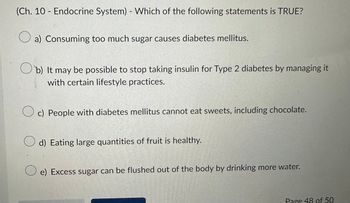
Human Anatomy & Physiology (11th Edition)
11th Edition
ISBN: 9780134580999
Author: Elaine N. Marieb, Katja N. Hoehn
Publisher: PEARSON
expand_more
expand_more
format_list_bulleted
Question

Transcribed Image Text:(Ch. 10 - Endocrine System) - Which of the following statements is TRUE?
a) Consuming too much sugar causes diabetes mellitus.
b) It may be possible to stop taking insulin for Type 2 diabetes by managing it
with certain lifestyle practices.
Oc) People with diabetes mellitus cannot eat sweets, including chocolate.
d) Eating large quantities of fruit is healthy.
O e) Excess sugar can be flushed out of the body by drinking more water.
Page 48 of 50
Expert Solution
This question has been solved!
Explore an expertly crafted, step-by-step solution for a thorough understanding of key concepts.
Step by stepSolved in 3 steps

Knowledge Booster
Learn more about
Need a deep-dive on the concept behind this application? Look no further. Learn more about this topic, biology and related others by exploring similar questions and additional content below.Similar questions
- Describe the cause for the following diseases: Pituitary dwarfism, Diabetes mellitus, Graves' disease, Addison’s diseasearrow_forwardDescribe the prevention of Diabetes Mellitus on primary, secondary, and tertiary levels and which age should primary prevention begin for this disease?arrow_forwardCan diabetic complications be controlled by insulin therapy alone?arrow_forward
- Why is diabeties so prevalent and what technologies are used to treat diabetic patients?arrow_forwardTo help with the insomnia associated with thyroid hormone replacement therapy, the nurse will teach the patient to a) take half the dose at lunchtime and the other half 2 hours later.b )use a sedative to assist with falling asleep.c )take the dose upon awakening in the morning.d )reduce the dosage as needed if sleep is impaired.arrow_forwardThe nurse monitoring a patient for a therapeutic response to oral antidiabetic drugs will look for a) fewer episodes of diabetic ketoacidosis (DKA).b )weight loss of 5 pounds.c) hemoglobin A1C levels of less than 7%.d )glucose levels of 150 mg/dLarrow_forward
- a. Individuals who have severe allergies (for example, to bee stings or peanut butter) often carry an EpiPen. It is a self-injecting device that delivers a single dose of 0.3 mg of epinephrine. Epinephrine (more familiarly known as adrenaline) is a hormone that responds to stress by increasing heart rate and blood pressure and boosting the supply of oxygen and energy-giving glucose to the blood and brain. Suppose the body loses 21% of the Epinephrine every hour. Find the amount of Epinephrine left in the body after 3 hours.arrow_forwardThe pathophysiology of chronic diabetic complications is related to which process? Question 65 options: a) Oxidative stress and ROS have a limited role in the pathophysiology of diabetes mellitus b) Sorbitol and fructose are products of the polyol pathway that accumulate and reduce intracellular osmotic pressure causing cellular injury c) AGEs are formed by the irreversible binding of glucose to proteins, lipids and nucleic acids d) The hexosamine pathway causes pathologic changes in gene expression associated with increased insulin activity and improved cardiovascular healtharrow_forward(Ch. 10 - Endocrine System) - If you haven't eaten for a few hours and your blood sugar is low, an appropriate response of the endocrine system would be to release: a) insulin b) glucagon c) cortisol d) A and B e) B and C Page 39 of 50arrow_forward
- (Ch. 10 - Endocrine System) - Which of the following could lead to hypothyroidism? a) damage to the hypothalamus Ob) damage to the pituitary gland O c) damage to the thyroid gland d) A, B, and C Page 1 of 50 e) B and C onlyarrow_forwardName the disorder caused by deficency of insulin.arrow_forward16arrow_forward
arrow_back_ios
SEE MORE QUESTIONS
arrow_forward_ios
Recommended textbooks for you
 Human Anatomy & Physiology (11th Edition)BiologyISBN:9780134580999Author:Elaine N. Marieb, Katja N. HoehnPublisher:PEARSON
Human Anatomy & Physiology (11th Edition)BiologyISBN:9780134580999Author:Elaine N. Marieb, Katja N. HoehnPublisher:PEARSON Biology 2eBiologyISBN:9781947172517Author:Matthew Douglas, Jung Choi, Mary Ann ClarkPublisher:OpenStax
Biology 2eBiologyISBN:9781947172517Author:Matthew Douglas, Jung Choi, Mary Ann ClarkPublisher:OpenStax Anatomy & PhysiologyBiologyISBN:9781259398629Author:McKinley, Michael P., O'loughlin, Valerie Dean, Bidle, Theresa StouterPublisher:Mcgraw Hill Education,
Anatomy & PhysiologyBiologyISBN:9781259398629Author:McKinley, Michael P., O'loughlin, Valerie Dean, Bidle, Theresa StouterPublisher:Mcgraw Hill Education, Molecular Biology of the Cell (Sixth Edition)BiologyISBN:9780815344322Author:Bruce Alberts, Alexander D. Johnson, Julian Lewis, David Morgan, Martin Raff, Keith Roberts, Peter WalterPublisher:W. W. Norton & Company
Molecular Biology of the Cell (Sixth Edition)BiologyISBN:9780815344322Author:Bruce Alberts, Alexander D. Johnson, Julian Lewis, David Morgan, Martin Raff, Keith Roberts, Peter WalterPublisher:W. W. Norton & Company Laboratory Manual For Human Anatomy & PhysiologyBiologyISBN:9781260159363Author:Martin, Terry R., Prentice-craver, CynthiaPublisher:McGraw-Hill Publishing Co.
Laboratory Manual For Human Anatomy & PhysiologyBiologyISBN:9781260159363Author:Martin, Terry R., Prentice-craver, CynthiaPublisher:McGraw-Hill Publishing Co. Inquiry Into Life (16th Edition)BiologyISBN:9781260231700Author:Sylvia S. Mader, Michael WindelspechtPublisher:McGraw Hill Education
Inquiry Into Life (16th Edition)BiologyISBN:9781260231700Author:Sylvia S. Mader, Michael WindelspechtPublisher:McGraw Hill Education

Human Anatomy & Physiology (11th Edition)
Biology
ISBN:9780134580999
Author:Elaine N. Marieb, Katja N. Hoehn
Publisher:PEARSON

Biology 2e
Biology
ISBN:9781947172517
Author:Matthew Douglas, Jung Choi, Mary Ann Clark
Publisher:OpenStax

Anatomy & Physiology
Biology
ISBN:9781259398629
Author:McKinley, Michael P., O'loughlin, Valerie Dean, Bidle, Theresa Stouter
Publisher:Mcgraw Hill Education,

Molecular Biology of the Cell (Sixth Edition)
Biology
ISBN:9780815344322
Author:Bruce Alberts, Alexander D. Johnson, Julian Lewis, David Morgan, Martin Raff, Keith Roberts, Peter Walter
Publisher:W. W. Norton & Company

Laboratory Manual For Human Anatomy & Physiology
Biology
ISBN:9781260159363
Author:Martin, Terry R., Prentice-craver, Cynthia
Publisher:McGraw-Hill Publishing Co.

Inquiry Into Life (16th Edition)
Biology
ISBN:9781260231700
Author:Sylvia S. Mader, Michael Windelspecht
Publisher:McGraw Hill Education